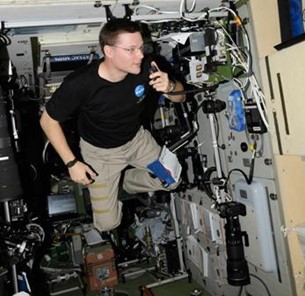There’s an impressive history of amateur radio operators who have stood on the leading edge of space activities. Examples include the amateur radio moonbounce, or Earth-Moon-Earth (EME), by W4AO and W3GKP back in 1953; OSCAR 1 (Orbiting Satellites Carrying Amateur Radio) launched in 1961; talking with licensed astronauts in space, beginning with Owen Garriott, W5LFL, in 1983 (Space Shuttle mission STS-9 on 2M); and interplanetary communications since 2009 with the Earth-Venus-Earth bounce by German AMSAT-DL.
EME regularly takes place on all amateur bands from 50 MHz up to 47 GHz, with 144 MHz and 1296 MHz by far the most popular bands for activity. Some EME activity has even taken place on the 21 and 28 MHz amateur bands.
Amateur satellites operate primarily in the amateur bands from 21 MHz to 10 GHz. They can be used to provide communications using SSB, FM, or digital modes over long distances at VHF and UHF. Using the moon as a passive reflector for EME also exploits VHF/UHF and higher frequencies that can be transmitted through the ionosphere.
Since the earliest days of the Space Shuttle, many astronauts have become licensed radio amateurs to communicate with stations on Earth while traveling in space and onboard the International Space Station (ISS), which has equipment for amateur radio voice, data, and TV.


Not all licensed astronauts were part of missions that involved active participation in amateur radio activities. In some cases, unlicensed astronauts conducted amateur radio contacts under third-party supervision of licensed astronauts.
As reported by the ARRL in October 2010, the image above shows ISS Expedition 25 Commander Doug Wheelock, KF5BOC, speaking to Earth via ham radio from NA1SS. The transceiver control head is just visible on the cluttered bulkhead, with operating instructions posted conveniently adjacent. All gear is secured so it doesn’t float around the cabin.
From nasa.gov:
As of November 2023, students have been talking to astronauts in space for 40 years. Crew members on the space shuttle Columbia first used an amateur radio to communicate with people on Earth in 1983. That program, the Shuttle Amateur Radio Experiment (SAREX), ended in 1999.
In October 2000, amateur radio equipment was launched to the space station along with its first crew members, who deployed it on November 13, 2000. ISS Ham Radio, also known as Amateur Radio on the International Space Station (ARISS), has operated continuously since then. Each year, the program hosts about a hundred contacts. It has now directly connected over 100 crew members with more than one million student participants from 49 U.S. states, 63 countries, and every continent. These experiences encourage interest in science, technology, engineering, and mathematics (STEM) education and help inspire the next generation.
Before a scheduled contact, students study related topics. They have about nine minutes to ask questions, often discussing career choices and scientific activities aboard the orbiting laboratory. Read this OnAllBands article about young hams contacting the ISS last December.
According to amsat-dl.org, on March 25, 2009 at 10:38 UTC, the team of the German space agency AMSAT-DL reached a milestone on the way to Mars with its own probe. The ground and control station at the observatory in Bochum, Germany, sent radio signals to Venus. After traveling almost 100 million kilometers and a runtime of about five minutes, they were received back in Bochum as an echo from the surface of Venus. For the first time in Germany and Western Europe, it was possible to receive echoes from other planets. At the same time, this is the greatest distance ever bridged in amateur radio, over one hundred times farther than EME reflections.
FFT technique with an integration time of five minutes was used in receiving the EVE reflections. After an integration time of two minutes the reflected signals were clearly visible. Despite showery weather, the signals from Venus could be received continuously with the 20M antenna from 10:38 UTC until its setting in the evening.
Questions? Share them in the comments below or email me at KE8FMJ@gmail.com

